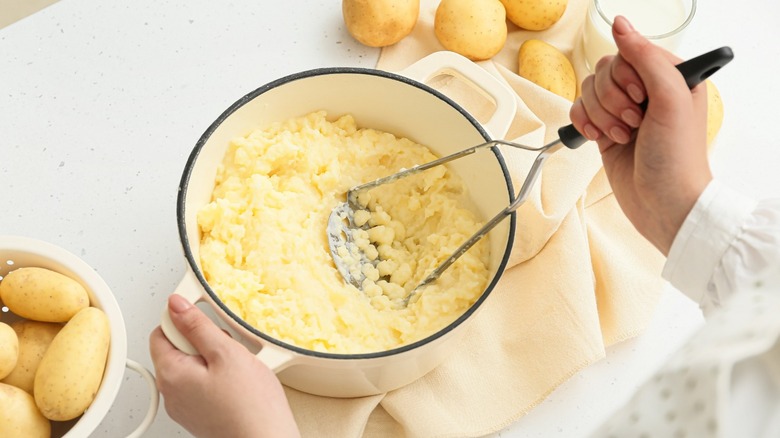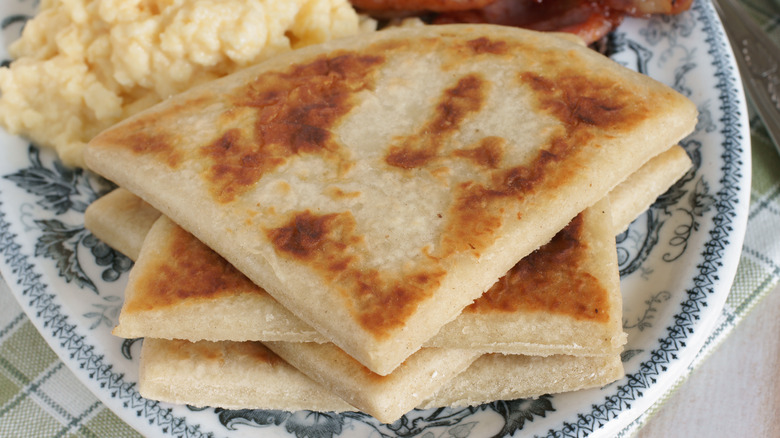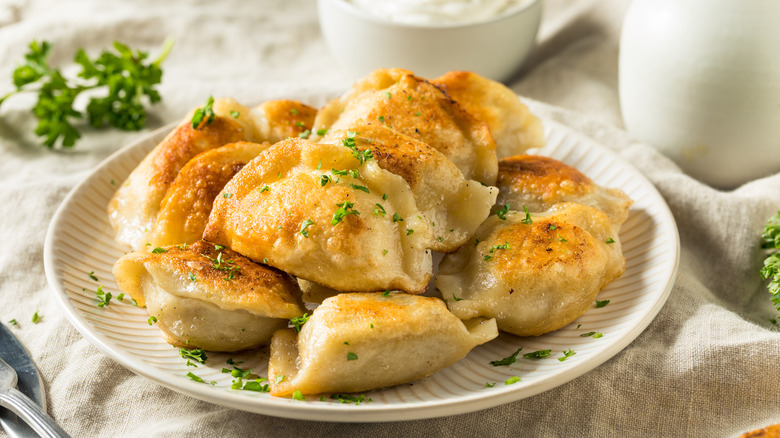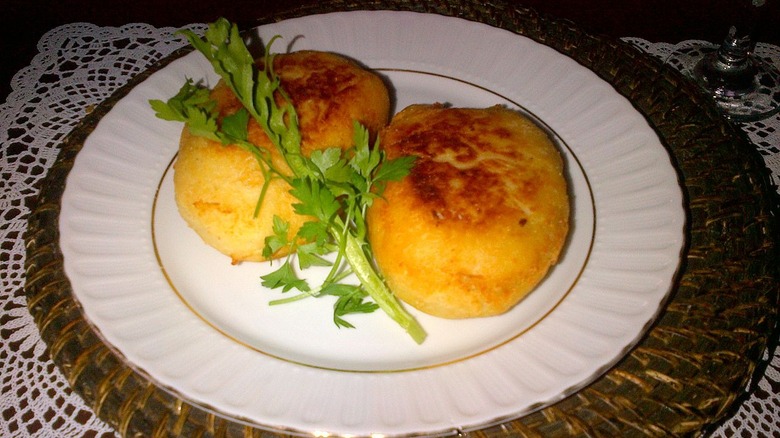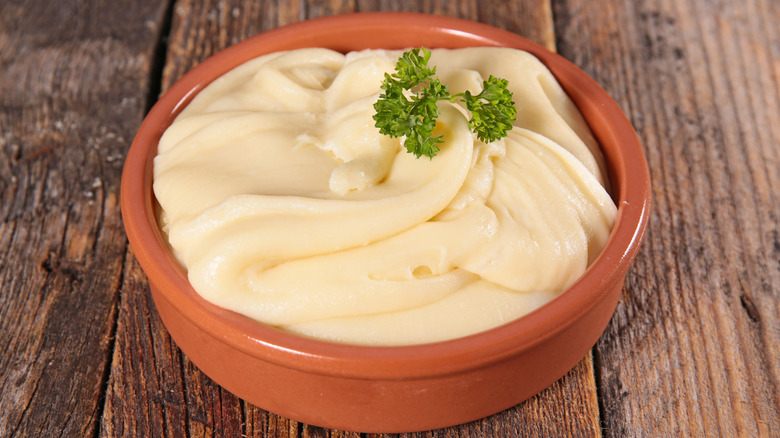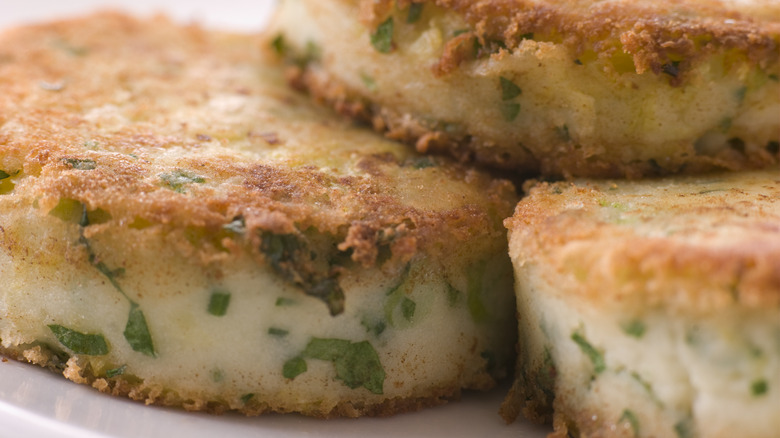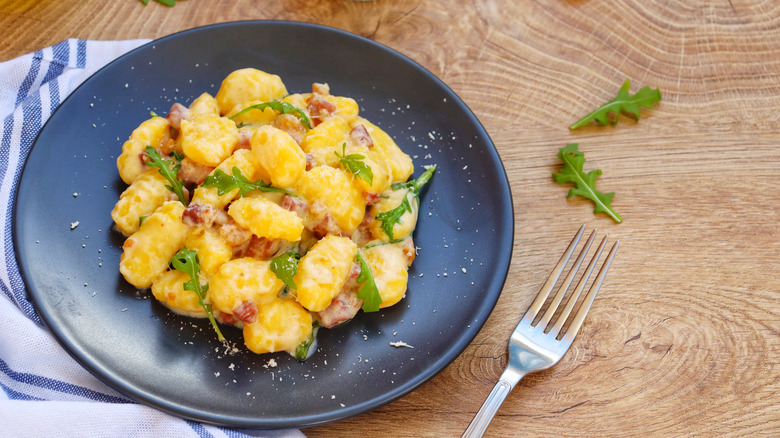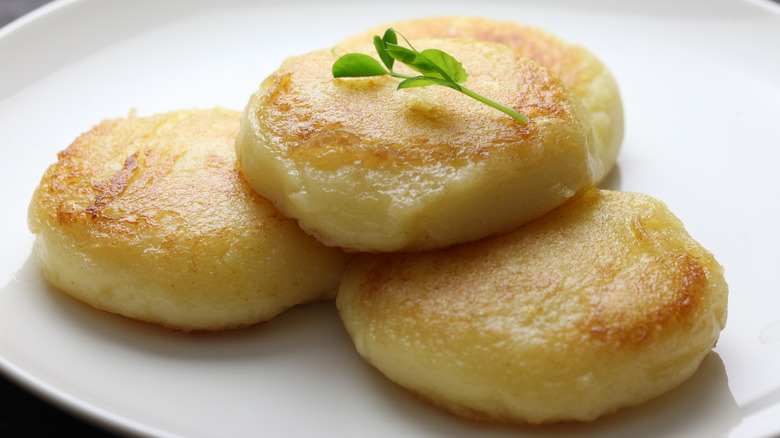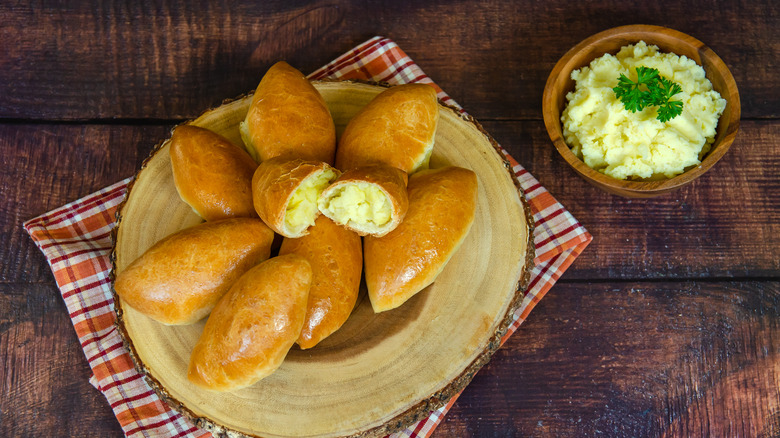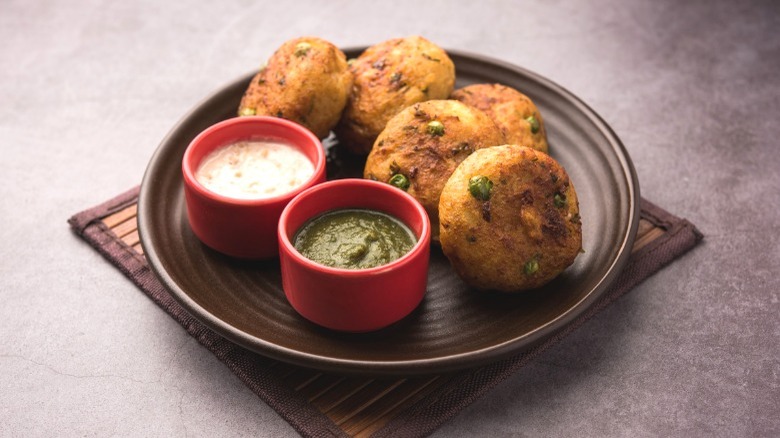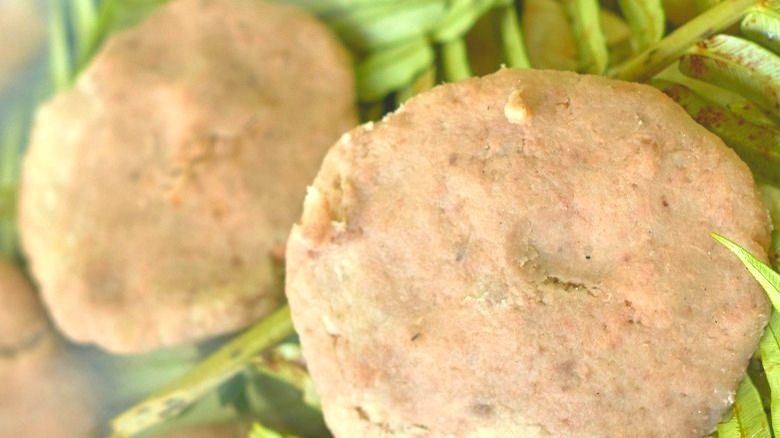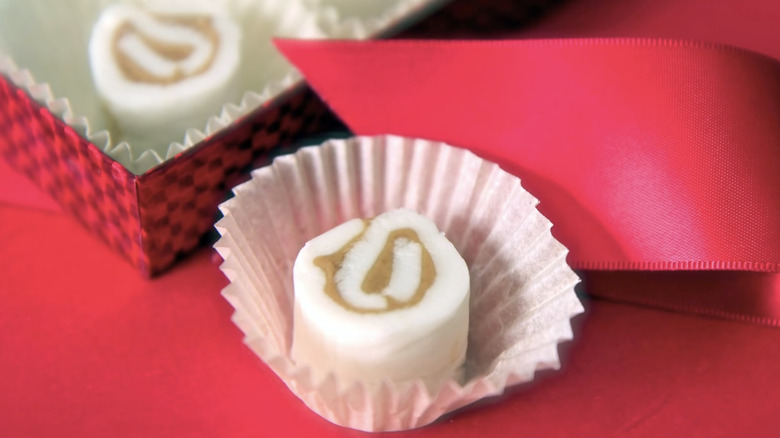What To Do With Leftover Mashed Potatoes
Potatoes are wonderful! They're versatile, flexible, and an important dietary staple across the world. According to Potato Country, the humble potato is consistently recognized as "America's favorite vegetable," eaten weekly by nearly 80% of people across the United States. The popularity of the potato crosses international boundaries too, with potatoes being one of the most widely enjoyed vegetables in the world. Per The Packer, the only fresh produce people in the U.S. buy more than potatoes is the banana. As this country's undefeated king of vegetables, needless to say, there are a huge variety of ways to prepare and enjoy them, often making for wholesome and easy-to-cook meals.
A firm favorite way for many is to boil and mash them. Fluffy and creamy, mashed potatoes makes for a delicious and filling comfort food. While a bowl of leftover mashed potatoes can be simply used as a side dish or livened up by adding things like scallions or bacon bits, it can also be an excellent cooking ingredient in its own right. Mashed potatoes offer a fine opportunity to flex your culinary muscles and consider making any number of interesting dishes eaten around the globe. There's a whole world of delicious mashed potato dishes out there, with many being just as fun to cook as they are to eat!
Potato farls
Ireland is well known for its potatoes, and for good reason. The Irish were among the earliest Europeans to make the potato an essential part of their diet. In the 17th century, as the World Potato Congress explains, Ireland was the first country in Europe to grow the world's favorite root vegetable as a major crop, and the plants there thrived in near-ideal growing conditions. One deliciously Irish way to enjoy potatoes is to make potato farls, and leftover mash is the perfect place to start.
According to The Guardian, these delectable potato cakes are exceptionally easy to make, being little more than butter, potatoes, and plain flour (although they were traditionally made with oatmeal). The word "farls" means quarters because farls are normally cut into four pieces from a circle of dough before being served. The Irish Times describes how potato farls are just as adaptable as the potatoes themselves, going excellently with anything from smoked fish to a fresh salad. You can even cook a sweet version by adding in some currants and spices, like fruit scones. However, they're most popularly made so the potato flavor is front and center, using as little flour as possible. Quick to prepare, a batch of plain potato farls will make for an excellent breakfast, with some bacon and eggs, or a tasty side dish at any time of day.
Pierogi
Pierogi are probably the food Poland is most famous for. These small, semicircular dumplings are iconic and easy to recognize, popularly served as street food, not only in Poland but also in places like New York. Deliciously moreish, Culture.pl explains how pierogi can be cooked in a variety of ways, from boiling to deep frying. They're also endlessly versatile, made with all kinds of fillings from bacon to sauerkraut to forest mushrooms. They can even be served with sweet fillings, like apricots or cherries, and dessert pierogi are sometimes served with a rich chocolate ganache. The classic, and most common type, however, has a simple cheese and potato filling, and leftover mashed potatoes are an ideal ingredient to make them with.
With a handful of basic ingredients, you can transform a spare bowl of potatoes into a plate of delicious pierogi with a satisfyingly creamy cheese and potato filling. Making dumplings can be a little tricky at first, so you might need some practice, but the end result is definitely worthwhile. Experts recommend not making the pastry too thick, to keep the finished pierogi light and not too chewy. This classic Polish comfort food can be enjoyed at any time of day and goes very nicely with some sour cream and a little black pepper.
Papa rellena
If the potato has a true home, it's in Peru, where potatoes were first domesticated over 8,000 years ago; they've been enjoyed in Peruvian cuisine for far longer than Peru has existed as a country. According to Peru.travel, Peru is now the main supplier of potatoes throughout Latin America, with a dazzling 4,000 different varieties grown around the country. Needless to say, Peruvians are experts at preparing potatoes, and papa rellena is one exceedingly popular dish that uses mashed potatoes as the main ingredient.
Papas rellenas are enjoyed across Peru, and Amigo Foods mentions that they're among the best street foods. A kind of croquette made from mashed potatoes and stuffed with spiced beef and onions, papas rellenas are also just as often found on the dining table, both at home and in restaurants. Essentially, they aren't too different from empanadas, except made with potato instead of pastry. Peru.travel describes them as "one of the greatest gastronomic treasures that [Peru] has," mentioning how they're best when cooked to have a crispy exterior. With a bowl of light, fluffy mashed potatoes as a starting ingredient, these delectable little snacks aren't too difficult to make and are tasty enough that you're likely to find yourself craving more.
Aligot
Rich, wholesome foods are one of the things that France does best, and aligot is a wonderfully warming dish to enjoy on a cold day. It's a traditional dish from the Aubrac, in the heart of France's central highlands. Quite similar to fondue, Connexion France tells the story of how this dish has been a part of French cuisine for centuries. Reportedly, the original version didn't actually use potatoes. It was first served by monks in the 12th century, long before potatoes were brought to Europe.
Leftover mashed potatoes are already a perfect start for this dish, which can be beautifully soothing after a tiring day. All aligot needs are mashed potatoes, crème fraîche, a pinch of salt, and some cheese. Made properly in the old-fashioned way, a good aligot should be able to stretch into long ribbons, like hot mozzarella on a pizza. The cheese traditionally used is Aubrac Tome, although this may be difficult to find in some parts of the world, and other types of cheese can easily be substituted when making aligot at home. A few other things can be added to the recipe too, according to the tastes of the cook, from the garlic often used in home kitchens to the black truffles included by Michelin-starred restaurants. It can be served as a side dish with other foods, or it can be just as easily enjoyed the traditional way and eaten all on its own.
Bubble and squeak
An old working-class favorite from the U.K., bubble and squeak is a dish that exists purely to use up leftovers, especially after a big family dinner. Per British Food: A History, it doesn't have any particular recipe, being essentially a big collection of leftover vegetables, often including things like cabbage, broccoli, and carrots. The main ingredient, though, is mashed potatoes, which are essential to hold everything together (although some people like to add an egg as a binder to stop it from falling apart too easily). The whole mixture is combined together and formed into small patties, which are then pan-fried until they have a nice golden crust on either side. The name comes from the sound this dish makes while it's in the frying pan, as hot steam from the vegetables escapes.
With mashed potatoes as the basic ingredient, the modern dish is usually made entirely of vegetables (although the original version was much more meaty). It isn't purely restricted to vegetables, however, and as long as it's at least half potato, anything goes! Because it's such a flexible dish, it can also be a good way to use up stray items in your fridge, like the last slice of bacon or a spare half onion. If you live in the kind of household that enjoys a roast dinner on Sundays, bubble and squeak is a quick and easy breakfast for a Monday morning.
Gnocchi
Any connoisseur of Italian food will certainly be familiar with gnocchi. These puffy, pillowy little pasta nuggets originate from Northern Italy; with a cooler climate than the rest of Italy, it happens to be a great environment in which to grow potatoes. As DeLallo explains, while gnocchi is enjoyed for its rich potato flavor, older versions of them were made with ingredients ranging from squash to breadcrumbs. Gnocchi can be served in ways similar to most any other kind of pasta, perhaps with pesto or a nice ragu, maybe baked or as part of a salad. Most Italians, however, like to keep things simple. A little fresh sage for seasoning and a nice buttery sauce is the most popular way to serve these tiny potato dumplings in their home country.
Leftover mashed potatoes are an excellent starting point to make some mouthwatering gnocchi and, as The Irish Times explains, it's both cheap and easy to do. Preparing them yourself means you can also mix in some chopped herbs as you make them. Very convenient if you need to use up any fresh herbs that might be slightly past their prime. A hearty bowl of gnocchi can make for an easy weekday lunch, not too involved to make and not too heavy on the stomach, so it won't leave you feeling tired in the afternoon.
Imo mochi
One quintessentially Japanese food is mochi, a kind of chewy rice cake with a veritable galaxy of variations. Made from a particular kind of glutinous rice to give its characteristic gummy texture, mochi is widely found in Japanese sweets but can also be eaten in savory dishes (via Tofugu). However, as well as rice, mochi can also be made from potatoes. Named imo mochi (literally "potato mochi"), it's a popular snack across the country, but particularly in Japan's northern island of Hokkaido. Potatoes in general are strongly associated with Hokkaido because, according to The Japan Times, this is where farmers first started growing them in the 18th century. In the cold climate of Hokkaido, buttery potato dishes are unfailingly popular.
Imo mochi is extremely easy to make. As Miklia explains, they're little more than mashed potato and potato starch –- not unlike other potato cakes, but the starch gives them a very different texture. With the ingredients mixed together, the mochi is shaped into little round patties and pan-fried until slightly crispy on the outside. They're then usually served with a sweet-savory dipping sauce made from soy sauce or miso, giving a rich, wholesome flavor. A plate of them can be surprisingly filling. Being so simple to prepare, imo mochi can make for a handy snack at any time of day. They have a soft, chewy texture and are best enjoyed while still hot and springy.
Pirozhki
The name may sound very similar to pierogi, but don't be fooled. These fried dumplings (or are they pies?), popularly enjoyed in Ukraine and Russia, are an entirely different thing. Per Door Dash, pirozhki were originally made in the 1700s for miners to carry for their lunch. They're now enjoyed in Russian communities around the world, either baked or fried, and can have a variety of fillings. As Delighted Cooking explains, pirozhki are made with yeast-leavened dough, giving them a bread-like texture, and are sometimes glazed with egg before cooking, for a golden brown appearance. Among the many fillings which pirozhki can have, mashed potatoes are a popular ingredient.
One traditional pirozhki filling is liver and mashed potato, with the potato softening the flavor of the liver to make it a lot milder than it may sound (although it's also okay to swap the liver for something like mushrooms if you'd prefer). Pirozhki may seem quite involved to make but, as Alonya's Cooking explains, it's easier than it may seem at first. It just involves making a kind of bread dough and wrapping it around the filling. The resulting boat-shaped parcels can be easily fried, either deep or shallow, puffing up in size as they cook to give a light and fluffy exterior. Besides being rich and hearty, this is one Slavic comfort food that is most definitely worth the effort to make.
Aloo tikki
India is a bustling country full of vibrant cities with an incredible variety of foods, and widely eaten across India are bite-sized foods called chaat. As Bon Appetit explains, the infamously moreish chaat can be eaten as snacks in smaller portions, but is substantial enough that a larger serving can make for a full meal. Chaat is also enough of a staple that you can find it in some form anywhere in India, and Indian supermarkets across the world will almost certainly have some on offer too. The specific names and styles can vary wildly, but a few varieties of chaat are so popular that they're quite easy to find. One of the most common ones is aloo tikki.
The main ingredient of aloo tikki is mashed potato. MasterClass mentions how it's seasoned with spice mixes like garam masala, and can even be stuffed with paneer (Indian cheese) or chana dal (split chickpeas). These small potato patties can be deep-fried or shallow-fried, but the most important part is that they should have a nice crisp golden crust. They're popularly served with liberal amounts of condiments like yogurt dips or spicy chutneys. It's even quite popular in India for fast food restaurants to serve a vegetarian option of aloo tikki burgers, a now beloved food that reportedly originated on McDonald's menus.
Chapalele
Originally from Chiloé Island in southern Chile, chapalele is a type of potato bread that makes an excellent side dish with a flavorsome stew, though it can just as easily be eaten on its own. It's also very simple to make. Per The World of Wine and Food: A Guide to Varieties, Tastes, History, and Pairings, the two basic ingredients are flour and mashed potatoes, making it quick and easy to prepare. Traditionally, chapalele is cooked in a type of earth oven called a curanto, in which the potato breads are steamed to perfection alongside a full meal. Fortunately, for easier preparation, chapaleles can also be baked or pan-fried. According to An Eccentric Culinary History, they can also contain lard as an ingredient, and they're one of many dietary staples among the Chilote people who use potatoes because of how readily available they are.
Chile is home to a few other foods which use mashed potato as a main ingredient, such as chochoca. Per The Economist, this is a kind of thin potato bread cooked over open flames while wrapped around a large wooden stick. When cooked, and slightly charred at the edges, it's sliced and served folded. Unfortunately, chochoca might be rather difficult for most people to cook in their kitchens using leftover mash. Chapalele, on the other hand, is both quick and easy.
Potato candy
Potato candy is a favorite treat in Appalachia, especially during the holiday season. Enough to please anyone with a sweet tooth, potato candy sits comfortably alongside fudge and taffy as a wintery indulgence. Unlike fudge though, potato candy doesn't involve any boiling or setting. It's much easier to make, being mostly just mashed potato and sugar. According to True Treats Candy, potato candy most likely arrived with immigrants and became popular because of how cheap and readily available its ingredients are.
The recipe is a simple mixture of potato and powdered sugar, topped with a layer of peanut butter and wrapped up like a jelly roll. A true working-class delight, ingenious cooks helped to make it particularly popular during the Great Depression, with potatoes being cheap and easy to grow. The result is a sweet-tasting candy, replete with the nutty richness of peanut butter, which also makes an attractive addition to dessert tables during the holidays. Of course, there's no reason why you have to wait. With some leftover mashed potatoes as a starting point, this dish is so easy to prepare that it can be enjoyed year-round.
